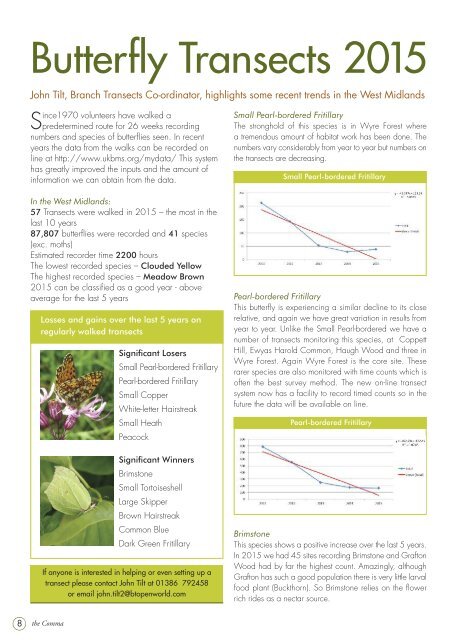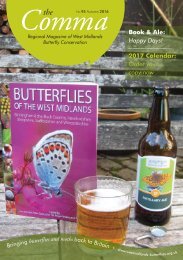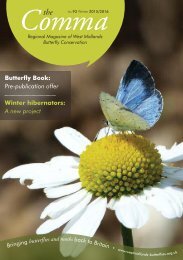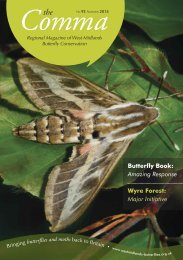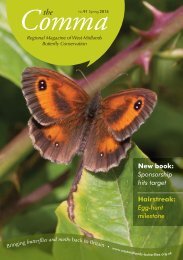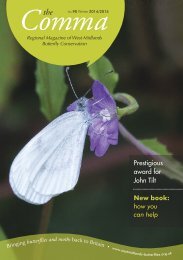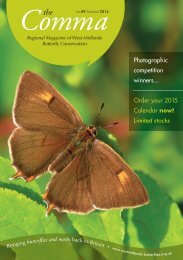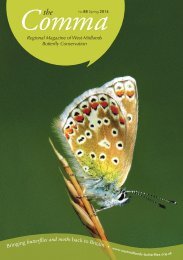Comma No94 Spring 2016
32 page Butterfly Magazine designed for the West Midlands branch of Butterfly Conservation
32 page Butterfly Magazine designed for the West Midlands branch of Butterfly Conservation
Create successful ePaper yourself
Turn your PDF publications into a flip-book with our unique Google optimized e-Paper software.
Butterfly Transects 2015<br />
John Tilt, Branch Transects Co-ordinator, highlights some recent trends in the West Midlands<br />
Since1970 volunteers have walked a<br />
predetermined route for 26 weeks recording<br />
numbers and species of butterflies seen. In recent<br />
years the data from the walks can be recorded on<br />
line at http://www.ukbms.org/mydata/ This system<br />
has greatly improved the inputs and the amount of<br />
information we can obtain from the data.<br />
Small Pearl-bordered Fritillary<br />
The stronghold of this species is in Wyre Forest where<br />
a tremendous amount of habitat work has been done. The<br />
numbers vary considerably from year to year but numbers on<br />
the transects are decreasing.<br />
Small Pearl-bordered Fritillary<br />
In the West Midlands:<br />
57 Transects were walked in 2015 – the most in the<br />
last 10 years<br />
87,807 butterflies were recorded and 41 species<br />
(exc. moths)<br />
Estimated recorder time 2200 hours<br />
The lowest recorded species – Clouded Yellow<br />
The highest recorded species – Meadow Brown<br />
2015 can be classified as a good year - above<br />
average for the last 5 years<br />
Losses and gains over the last 5 years on<br />
regularly walked transects<br />
Significant Losers<br />
Small Pearl-bordered Fritillary<br />
Pearl-bordered Fritillary<br />
Small Copper<br />
White-letter Hairstreak<br />
Small Heath<br />
Peacock<br />
Significant Winners<br />
Brimstone<br />
Small Tortoiseshell<br />
Large Skipper<br />
Brown Hairstreak<br />
Common Blue<br />
Dark Green Fritillary<br />
If anyone is interested in helping or even setting up a<br />
transect please contact John Tilt at 01386 792458<br />
or email john.tilt2@btopenworld.com<br />
Pearl-bordered Fritillary<br />
This butterfly is experiencing a similar decline to its close<br />
relative, and again we have great variation in results from<br />
year to year. Unlike the Small Pearl-bordered we have a<br />
number of transects monitoring this species, at Coppett<br />
Hill, Ewyas Harold Common, Haugh Wood and three in<br />
Wyre Forest. Again Wyre Forest is the core site. These<br />
rarer species are also monitored with time counts which is<br />
often the best survey method. The new on-line transect<br />
system now has a facility to record timed counts so in the<br />
future the data will be available on line.<br />
Pearl-bordered Fritillary<br />
Brimstone<br />
This species shows a positive increase over the last 5 years.<br />
In 2015 we had 45 sites recording Brimstone and Grafton<br />
Wood had by far the highest count. Amazingly, although<br />
Grafton has such a good population there is very little larval<br />
food plant (Buckthorn). So Brimstone relies on the flower<br />
rich rides as a nectar source.<br />
8<br />
the <strong>Comma</strong>


